Entry Database : PDB / ID : 1pkgTitle Structure of a c-Kit Kinase Product Complex c-kit protein Keywords / / / Function / homology Function Domain/homology Component
/ / / / / / / / / / / / / / / / / / / / / / / / / / / / / / / / / / / / / / / / / / / / / / / / / / / / / / / / / / / / / / / / / / / / / / / / / / / / / / / / / / / / / / / / / / / / / / / / / / / / / / / / / / / / / / / / / / / / / / / / / / / / / / / / / / / / / / / / / / / / / / / / / / / / / Biological species Homo sapiens (human)Method / / / Resolution : 2.9 Å Authors Mol, C.D. / Lim, K.B. / Sridhar, V. / Zou, H. / Chien, E.Y.T. / Sang, B.-C. / Nowakowski, J. / Kassel, D.B. / Cronin, C.N. / McRee, D.E. Journal : J.Biol.Chem. / Year : 2003Title : Structure of a c-Kit Product Complex Reveals the Basis for Kinase Transactivation.Authors : Mol, C.D. / Lim, K.B. / Sridhar, V. / Zou, H. / Chien, E.Y.T. / Sang, B.-C. / Nowakowski, J. / Kassel, D.B. / Cronin, C.N. / McRee, D.E. History Deposition Jun 5, 2003 Deposition site / Processing site Revision 1.0 Aug 12, 2003 Provider / Type Revision 1.1 Apr 29, 2008 Group Revision 1.2 Jul 13, 2011 Group / Version format complianceRevision 1.3 Aug 9, 2017 Group / Category Revision 1.4 Oct 16, 2024 Group Data collection / Database references ... Data collection / Database references / Derived calculations / Structure summary Category chem_comp_atom / chem_comp_bond ... chem_comp_atom / chem_comp_bond / database_2 / pdbx_entry_details / pdbx_modification_feature / pdbx_struct_conn_angle / struct_conn / struct_ref_seq_dif / struct_site Item _database_2.pdbx_DOI / _database_2.pdbx_database_accession ... _database_2.pdbx_DOI / _database_2.pdbx_database_accession / _pdbx_struct_conn_angle.ptnr1_auth_asym_id / _pdbx_struct_conn_angle.ptnr1_auth_comp_id / _pdbx_struct_conn_angle.ptnr1_auth_seq_id / _pdbx_struct_conn_angle.ptnr1_label_asym_id / _pdbx_struct_conn_angle.ptnr1_label_atom_id / _pdbx_struct_conn_angle.ptnr1_label_comp_id / _pdbx_struct_conn_angle.ptnr1_label_seq_id / _pdbx_struct_conn_angle.ptnr1_symmetry / _pdbx_struct_conn_angle.ptnr2_auth_asym_id / _pdbx_struct_conn_angle.ptnr2_auth_seq_id / _pdbx_struct_conn_angle.ptnr2_label_asym_id / _pdbx_struct_conn_angle.ptnr3_auth_asym_id / _pdbx_struct_conn_angle.ptnr3_auth_comp_id / _pdbx_struct_conn_angle.ptnr3_auth_seq_id / _pdbx_struct_conn_angle.ptnr3_label_asym_id / _pdbx_struct_conn_angle.ptnr3_label_atom_id / _pdbx_struct_conn_angle.ptnr3_label_comp_id / _pdbx_struct_conn_angle.ptnr3_label_seq_id / _pdbx_struct_conn_angle.ptnr3_symmetry / _pdbx_struct_conn_angle.value / _struct_conn.conn_type_id / _struct_conn.id / _struct_conn.pdbx_dist_value / _struct_conn.pdbx_leaving_atom_flag / _struct_conn.ptnr1_auth_asym_id / _struct_conn.ptnr1_auth_comp_id / _struct_conn.ptnr1_auth_seq_id / _struct_conn.ptnr1_label_asym_id / _struct_conn.ptnr1_label_atom_id / _struct_conn.ptnr1_label_comp_id / _struct_conn.ptnr1_label_seq_id / _struct_conn.ptnr1_symmetry / _struct_conn.ptnr2_auth_asym_id / _struct_conn.ptnr2_auth_comp_id / _struct_conn.ptnr2_auth_seq_id / _struct_conn.ptnr2_label_asym_id / _struct_conn.ptnr2_label_atom_id / _struct_conn.ptnr2_label_comp_id / _struct_conn.ptnr2_label_seq_id / _struct_conn.ptnr2_symmetry / _struct_ref_seq_dif.details / _struct_site.pdbx_auth_asym_id / _struct_site.pdbx_auth_comp_id / _struct_site.pdbx_auth_seq_id
Show all Show less Remark 999 SEQUENCE C-KIT IS A TYPE III RECEPTOR PROTEIN TYROSINE KINASE WITH A "SPLIT" KINASE DOMAIN, I.E. ... SEQUENCE C-KIT IS A TYPE III RECEPTOR PROTEIN TYROSINE KINASE WITH A "SPLIT" KINASE DOMAIN, I.E. THE TWO CONSERVED KINASE DOMAINS ARE INTERRUPTED BY A LARGE NON-CONSERVED INSERTION CALLED THE KINASE INSERTION DOMAIN (KID). IN THE CONSTRUCT THE KID RESIDUES 694-753 WERE DELETED AND REPLACED WITH TWO VECTOR RESIDUES (THR-SER).
 Open data
Open data Basic information
Basic information Components
Components Keywords
Keywords Function and homology information
Function and homology information Homo sapiens (human)
Homo sapiens (human) X-RAY DIFFRACTION /
X-RAY DIFFRACTION /  SYNCHROTRON /
SYNCHROTRON /  MOLECULAR REPLACEMENT / Resolution: 2.9 Å
MOLECULAR REPLACEMENT / Resolution: 2.9 Å  Authors
Authors Citation
Citation Journal: J.Biol.Chem. / Year: 2003
Journal: J.Biol.Chem. / Year: 2003 Structure visualization
Structure visualization Molmil
Molmil Jmol/JSmol
Jmol/JSmol Downloads & links
Downloads & links Download
Download 1pkg.cif.gz
1pkg.cif.gz PDBx/mmCIF format
PDBx/mmCIF format pdb1pkg.ent.gz
pdb1pkg.ent.gz PDB format
PDB format 1pkg.json.gz
1pkg.json.gz PDBx/mmJSON format
PDBx/mmJSON format Other downloads
Other downloads 1pkg_validation.pdf.gz
1pkg_validation.pdf.gz wwPDB validaton report
wwPDB validaton report 1pkg_full_validation.pdf.gz
1pkg_full_validation.pdf.gz 1pkg_validation.xml.gz
1pkg_validation.xml.gz 1pkg_validation.cif.gz
1pkg_validation.cif.gz https://data.pdbj.org/pub/pdb/validation_reports/pk/1pkg
https://data.pdbj.org/pub/pdb/validation_reports/pk/1pkg ftp://data.pdbj.org/pub/pdb/validation_reports/pk/1pkg
ftp://data.pdbj.org/pub/pdb/validation_reports/pk/1pkg Links
Links Assembly
Assembly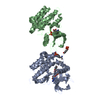


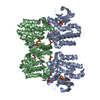
 Components
Components Homo sapiens (human) / Production host:
Homo sapiens (human) / Production host: 
 X-RAY DIFFRACTION / Number of used crystals: 1
X-RAY DIFFRACTION / Number of used crystals: 1  Sample preparation
Sample preparation SYNCHROTRON / Site:
SYNCHROTRON / Site:  ALS
ALS  / Beamline: 5.0.3 / Wavelength: 1 Å
/ Beamline: 5.0.3 / Wavelength: 1 Å Processing
Processing MOLECULAR REPLACEMENT / Resolution: 2.9→10 Å / Cor.coef. Fo:Fc: 0.917 / Cor.coef. Fo:Fc free: 0.834 / SU B: 24.258 / SU ML: 0.44 / Cross valid method: THROUGHOUT / σ(F): 0 / ESU R Free: 0.544 / Stereochemistry target values: MAXIMUM LIKELIHOOD
MOLECULAR REPLACEMENT / Resolution: 2.9→10 Å / Cor.coef. Fo:Fc: 0.917 / Cor.coef. Fo:Fc free: 0.834 / SU B: 24.258 / SU ML: 0.44 / Cross valid method: THROUGHOUT / σ(F): 0 / ESU R Free: 0.544 / Stereochemistry target values: MAXIMUM LIKELIHOOD Movie
Movie Controller
Controller



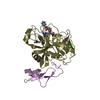
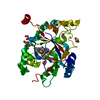


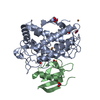

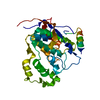
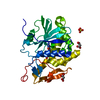
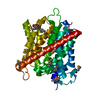

 PDBj
PDBj
















